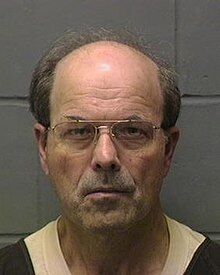Fantasies
Evolution of a Serial Killer: Dennis Rader, BTK
How it began for a serial killer
Posted February 7, 2022 Reviewed by Lybi Ma
Key points
- Rader admits to having killed cats and dogs by hanging and strangling them as a youth.
- By puberty he already dreamed of tying girls up and having sex with them.
- He began to enjoy what he called “trolling,” driving around certain neighborhoods to observe women and lust over them.
- By 1974, Rader was compelled to act on his obsessive fantasies of sex, torture, and murder.

Certain serial killers seem to become endless sources of intrigue and fascination for the public. One of them is Dennis Rader, the serial killer better known by his self-assigned pseudonym of “Bind, Torture, Kill” (BTK). Rader killed 10 people, including men, women, and children, between 1974 and 1991.
In between murders, he lived a remarkably normal-looking outward life with a wife and two children. He was perceived by acquaintances to be a pillar in his Wichita, Kansas, community. Inwardly, however, he was secretly satisfying his sexual needs and delaying his compulsion to kill for months and even years at a time by engaging in autoerotic fantasies until the need to commit murder became overwhelming once again.
The following, which is drawn from my actual correspondence with him over a three-year period, provides my thoughts on Rader’s early evolution leading up to his first murders.
By all accounts, the childhood of Dennis Lynn Rader was normal and unremarkable. He was born on March 9, 1945, in a quiet corner of Kansas, close to where it, Oklahoma, and Missouri all come together. His father was in the U.S. Marine Corps and later worked for the Kansas electric utility following World War II. Young Rader joined the Boy Scouts as a youth and participated in group activities at the Lutheran church.
He attended Riverview Elementary School, where he was an average to below-average student, and exhibited an introverted and withdrawn personality. By his own admission, Rader developed fantasies about domination, bondage, and torture at a very early age—while still in grade school. Dr. Tony Ruark, a forensic psychologist who evaluated Rader following his arrest, believes that something happened early in Rader’s life to spawn the BTK killer. He said:
If Rader was completely honest [which he is not] I am sure that we would find some sort of childhood event that Rader immediately associated with feelings of sexuality. Somehow, very early on, Rader encountered an event where he immediately linked sexual pleasure with watching a living creature suffer and die. And after that first encounter, Rader probably began to work very hard to nurture those feelings.
Rader admits to having killed cats and dogs by hanging and strangling them as a youth. By puberty, he already dreamed of tying girls up and having sex with them. He says that his fantasies were “almost like a picture show” that he wanted to direct and produce, no matter what the cost. Actress Annette Funicello, a “Mouseketeer” on the original Mickey Mouse Club TV show in the 1950s was one of his favorite targets for imaginary bondage.
The only social activities that Rader indulged in during his youth were related to his Lutheran church or the boy scouts. While he was a boy scout, he learned the art of tying knots that would help him later in life when he bound his victims before killing them.
Unceremoniously, he graduated from Wichita Heights High School in the class of 1963. He had a job for a time working in a local grocery store. In the summer of 1966, at the age of 21, Rader joined the U.S. Air Force, probably to avoid being drafted into the Vietnam War. While in the Air Force, Rader would peek through window blinds to watch women undress, and he broke into homes to steal their undergarments.
Less than a year following his return from the service to Wichita, on May 22, 1971, Rader married a young woman named Paula Dietz. In July 1973, He found employment with Cessna, a small aircraft manufacturer. In the fall of 1973, he began working toward a bachelor’s degree at Wichita State University. He dreamed of becoming a police officer.
In late 1973, Rader was let go by Cessna. He suddenly found himself unemployed, in a bad state of mind, unhappy, and with free time on his hands. He slipped deeper into the dark fantasy world that he had known since childhood and wanted to know just what it would feel like to strangle a woman with his bare hands until she died. He was obsessed with pornography and liked to daydream. He nicknamed his penis Sparky.
He began to enjoy what he called “trolling,” which meant driving or walking around certain neighborhoods and school campuses with young women for him to observe and lust over. Dennis stalked women as they shopped alone in grocery stores. He planned to hide in the backseat of their cars and kidnap them at gunpoint. He would focus on a good prospect and then enter into his fantasy of bondage, sex, and murder.
By 1974, Rader was compelled to act on his obsessive fantasies. He had trained himself how to kill and avoid detection. He had learned to tie knots and nooses. Dennis Rader was ready.
There was a new Latino family that had moved into his neighborhood and Rader lustfully noticed Julie Otero, age 34, and her daughter Josephine, age 11. He had a thing for Latinas, admiring their beautiful brown skin and dark hair. Rader stalked Julie and Josephine Otero for weeks to learn their daily routines. Based on what he learned from his surveillance, he devised a plan to take them by surprise in their own home.
Young Josephine was the prize he sought. He gathered together his so-called hit kit, which included a gun, knives, hoods, cords, tape, plastic bags, gloves, and various tools for breaking and entering. On the morning of January 15, he could wait no longer. At 8:20 am he went to the Otero house, entered the backyard, and cut the telephone line.
Upon entering the house, despite his careful planning, things did not go as he had expected. Rader discovered that in addition to the two females, Julie’s husband, Joe Otero, age 38, and Joey, the couple’s 9-year-old son, were also at home. The Otero’s three other children, Charlie, Danny, and Carmen, were not at home.
Undeterred, Rader somehow was able to control all four people using his gun. He told them he was a criminal on the run and needed money, food, and a car to escape. Using his cold, unemotional and nonthreatening demeanor, Rader convinced the Otero family that he meant no harm and he was able to get all of them tied up without incident.
Everything changed for the worse when Rader put a bag over Joe's head that morning. He was about to become a mass murderer by killing a family of four. In succession, Rader strangled and killed father Joe and little Joey. Mother Julie begged Rader to stop before she too was strangled to death.
Rader then moved on to his real target, the daughter Josephine. Rader forced her to go down into the basement where he hanged Josephine from a sewer pipe. In a letter to Rader, I asked him why he did this. His response was, "I thought it would be interesting to watch her die."
The horrible but well-orchestrated mass murder required surveillance, perfect timing, and the ability to subdue a group of people who were normally more than capable to defend themselves (Joe Otero was a former boxer and Julie practiced judo). The crime had the hallmarks of a military operation but there were also nagging details of sex and bondage that the police did not want to discuss with the press.
Thus began the killing career of Dennis Rader.
References
To read more about my interactions and correspondence with him, check out my book Why We Love Serial Killers: The Curious Appeal of the World’s Most Savage Murders.




